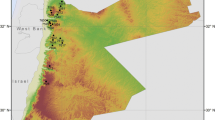Abstract
The phenotypic variation and response of plants to water stress were studied in a field trial in populations of wild barley, Hordeum spontaneum Koch. from Israel and Turkmenistan. Populations from the species distributional core and periphery were compared and contrasted for phenotypic variation in 16 phenological and morphological traits. The peripheral populations (six) were found to be phenotypically more variable and more resistant to water stress than core populations (12). The association of water-stress resistance with high phenotypic variability gives support to the hypothesis that populations that are genetically more variable are better adapted or pre-adapted to environmental changes and are thus valuable for conservation.
Similar content being viewed by others
References
Antonovics, J. (1994) Ecological genetics of metapopulations: the Silene-Ustilago Plant-Pathogen System. In Ecological Genetics (L. A. Real, ed.), pp. 146–70. New Jersey: Princeton University Press.
Bradshaw, A.D. (1965) Evolutionary significance of phenotypic plasticity in plants. Adv. Genetics 13, 115–55.
Brown, A.H.D., Nevo, E., Zohary, D. and Dagan, O. (1978) Genetic variation in natural populations of wild barley (Hordeum spontaneum). Genetica 49, 97–108.
Brussard, P. (1984) Geographic patterns and environmental gradients: the central-marginal model in Drosophila revisited. Annu. Rev. Ecol. Syst. 15, 25–64.
Carson, H.L. (1959) Genetic conditions that promote or retard the formation of species. Cold Spring Harbor Symp. Quant. Biol. 24, 87–103.
Chalmers, K.J., Waugh, R., Watters, J., Foster, B.P., Nevo, E., Abbott, R.J. and Powell, W. (1992) Grain isozyme and ribosomal DNA variability in Hordeum spontaneum populations from Israel. Theoret. App. Genetics 84, 313–22.
da Cunha, A.B. and Dobzhansky, T. (1954) A further study of chromosomal polymorphism in Drosophila willistoni in relation to environment. Evolution 8, 119–34.
Fisher, R.A. (1930) The General Theory of Natural Selection. Oxford: Clarendon Press.
Grime, J.P., Crick, J.C. and Rincon, E. (1986) The ecological significance of plasticity. In Plasticity in Plants (D.H. Jennings and A.J. Trewavas, eds), pp. 5–29. Cambridge: Company of Biologists.
Harlan, R.J. and Zohary, D. (1966) Distribution of wild wheats and barley. Science 153, 1074–80.
Jana, S. and Pietrzak, L.N. (1988) Comparative assessment of genetic diversity in wild and primitive cultivated barley in a center of diversity. Genetics 119, 981–90.
Lewontin, R.C. (1957) The adaptations of populations to varying environments. Cold Spring Harbor Symp. Quant. Biol. 22, 395–408.
Marshall, D.R. and Brown, A.H.D. (1975) Optimum sampling strategies in genetic conservation. In Crop Genetic Resources for Today and Tomorrow (O.H. Frankel and J.G. Hawks, eds), pp. 53–80. Cambridge: Cambridge University Press.
Marshall, D.M. and Jain, S.K. (1968) Phenotypic plasticity of Avena fatua and A. barbata. Am. Nat. 102, 457–67.
Mayr, E. (1965) Animal Species and Evolution. Cambridge, MA: Belkhap Press.
Mayr, E. (1970) Populations, Species, and Evolution. Cambridge, MA: Belkhap Press.
Mendlinger, S. and Zohary, D. (1995) The extent and structure of genetic variation in species of the Sitopsis group of Aegilops. Heredity 74, 616–27.
Nevo, E., Beiles, A., Gutterman, Y., Storch, N. and Kaplan, D. (1984) Genetic resources of wild cereals in Israel and vicinity. II. Phenotypic variation within and between populations of wild barley, Hordeum spontaneum. Euphytica 33, 737–56.
Nevo, E., Beiles, A. and Zohary, D. (1986) Genetic resources of wild barley in the Near East: structure, evolution and application in breeding. Biol. J. Linnean Soc. 27, 355–80.
Parsons, P.A. (1980) Adaptive strategies in natural populations of Drosophila: ethanol tolerance, dessication resistance, and development times in climatically optimal and extreme environments. Theoret. Appl. Genetics 57, 257–66.
Parsons, P.A. (1991) Evolutionary rates: stress and species boundaries. Annu. Rev. Ecol. Syst. 22, 1–18.
Pease, C.M., Lande, R. and Bull, J.J. (1989) A model of population growth, dispersal and evolution in a changing environment. Ecology 70, 1657–64.
Safriel, U.N., Volis, S. and Kark, S. (1994) Core and peripheral populations and global climate change. Israeli J. Plant Sci. 42, 331–45.
Saghai Maroof, M.A. and Allard, R.W. (1990) Genetic diversity and ecogeographical differentiation among ribosomal DNA alleles in wild and cultivated barley. Proc. Natl. Acad. Sci. USA 87, 8486–90.
Snow, L. and Brody, T. (1984) Genetic variation of Hordeum spontaneum in Israel: eco-geographical races, detected by trait measurements. Plant Syst. Evol. 145, 15–28.
Soule, M. (1973) The epistasis cycle: a theory of marginal populations. Annu. Rev. Ecol. Syst. 4, 165–87.
Ter Braak, C.J.F. (1987) Canoco-a Fortran Program for Canonical Community Ordination by (Partial) (Detrended) (Canonical) Correspondence Analysis, Principal Component Analysis and Redundancy Analysis. TNO Institute of Applied Computer Science, Wageningen.
Trevis, J. (1994) Ecological genetics of life-history traits: variation and its evolutionary significance. In Ecological Genetics (L.A. Real, ed.) pp. 171–204. New Jersey: Princeton University Press.
Zohary, D. (1973) Geobotanical Foundations to the Middle East, vols 1 and 2. Stuttgart: G. Fisher, and Amsterdam: Swets and Zeitlinger.
Author information
Authors and Affiliations
Rights and permissions
About this article
Cite this article
Volis, S., Mendlinger, S., Olsvig-Whittaker, L. et al. Phenotypic variation and stress resistance in core and peripheral populations of Hordeum spontaneum. Biodiversity and Conservation 7, 799–813 (1998). https://doi.org/10.1023/A:1008844504010
Issue Date:
DOI: https://doi.org/10.1023/A:1008844504010




